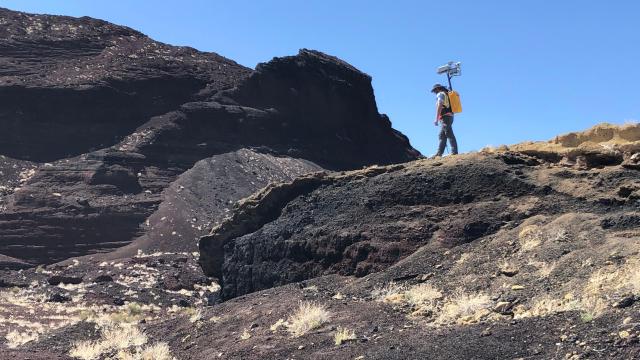The Moon is not the kind of place where you want to get lost, but it can get a little tricky trying to retrace your dusty footsteps without a GPS system in place. Thankfully, space engineers may have found a way around this limitation, designing a portable backpack meant to generate a real-time, 3D map of the Moon’s terrain.
The Kinematic Navigation and Cartography Knapsack (KNaCK) is a collaborative effort between NASA and its private industry partners to help future explorers find their way around the less-explored south polar regions of the Moon. KNaCK allows for an on-demand, real-time navigation system, and it works by using a pulsed laser that measures distances to nearby objects and surface features. On the Moon, the system could provide backpack-wearing astronauts with a 3D, high-resolution map of their surrounding area, according to NASA.
The technology is referred to as frequency modulated continuous wave lidar, and it’s capable of providing velocity and range for millions of measurement points per second, including the speed of and distance to disturbed dust particles. That is, in a word, impressive.

“Basically, the sensor is a surveying tool for both navigation and science mapping, able to create ultra-high-resolution 3D maps at centimeter-level precision and give them a rich scientific context,” Michael Zanetti, who leads the KNaCK project at NASA’s Marshall Space Flight Centre, said in a statement. “It also will help ensure the safety of astronauts and rover vehicles in a GPS-denied environment such as the Moon, identifying actual distances to far-off landmarks and showing explorers in real time how far they’ve come and how far is left to go to reach their destination.”
NASA is planning to return humans to the Moon no earlier than 2025 as part of the Artemis program. But this time, the astronauts will be landing near the Moon’s south pole. This area is of special interest to scientists, with evidence suggesting that it may contain subsurface water ice that can be used as a precious resource for lunar exploration.
However, much of the Moon’s south pole is covered in shadows, which could make it difficult for future astronauts to estimate distances to their lunar pit stops. As time spent on the Moon’s surface is precious, KNaCK will make it easier to measure the exact amount of oxygen needed for extra-vehicular excursions.
“As human beings, we tend to orient ourselves based on landmarks — a specific building, a grove of trees,” Zanetti said. “Those things don’t exist on the Moon. KNaCK will continuously enable explorers traversing the surface to determine their movement, direction, and orientation to distant peaks or to their base of operations. They can even mark specific sites where they found some unique mineral or rock formation, so others can easily return for further study.”
KNaCK underwent testing in November 2021 at an ancient volcanic crater in Potrillo, New Mexico, and is scheduled for another test in late April at NASA’s Solar System Exploration Research Virtual Institute (SSERVI) in Kilbourne Hole, New Mexico. The team behind the navigation system is working to reduce the weight of the backpack, which currently stands at about 18 kg, and to shield the electronics against the harsh solar radiation and microgravity experienced on the Moon.
More: NASA Chose a Really Sweet Spot to Land Its Upcoming Lunar Rover.
Editor’s Note: Release dates within this article are based in the U.S., but will be updated with local Australian dates as soon as we know more.
